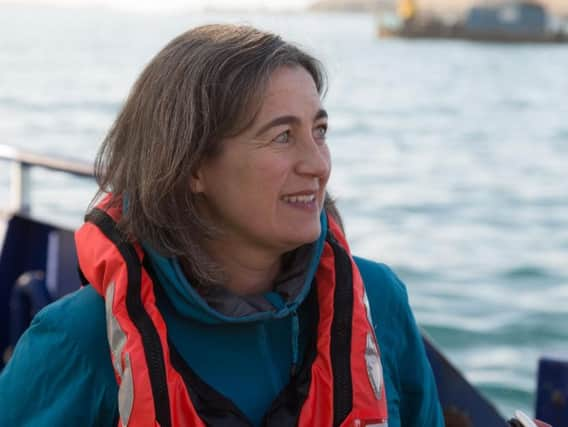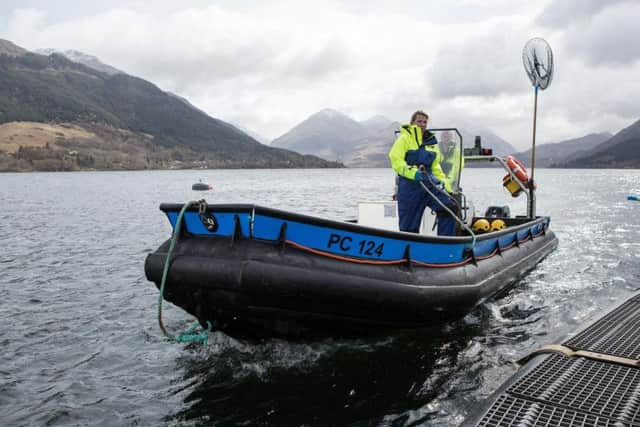Scottish salmon 'a worldwide success story'


In most new jobs there’s a bit of a “bedding in” period. A chance to get the feet under the desk, figure out the voicemail and get to know your new colleagues.
But by day two in her new role, Julie Hesketh-Laird had already rolled up her sleeves and swapped her office clothes for waterproofs and wellies.
Her new desk was somewhere 320 miles south in Perth. Ahead of her was a wild rolling island landscape and the sharp end of an industry currently balancing its hard-won status as the UK’s leading food export with defending itself from its critics.


Within moments of stepping off the plane in Shetland, the new chief executive of the Scottish Salmon Producers Organisation was discovering how much the sector means to rural communities which eat, live, breathe and sleep it every day of their lives.
“I was struck by the professionalism of the people I met and the passion they had for their work,” she recalls.
“How fully committed they are to fish health and environment sustainability.
“They really believe in what they are doing and are fantastic ambassadors for the industry.”
The salmon industry in Shetland alone employs more than 400 people directly – hundreds more indirectly – and is worth £45 million to the island in salaries and local spend with businesses.
But its day to day impact on Shetland’s shops, hotels, bars and businesses took even her by surprise.
“I was struck by the number of people that I met in the hotel in Scalloway, the shop where I bought my lunchtime sandwich, the airport, who all knew someone or had someone close to them who depended significantly on salmon farming.
“The hotel was full with people visiting, working in, inspecting or who were part of the salmon farm supply chain,” she adds.
“In Shetland, there is overwhelming support for the industry. In many ways, it’s an economic lifeline.”
Scottish farmed salmon is a national success story. The sector has dramatically grown over the past 40 years, from barely existing to an industry valued at more than £1 billion – £600m of fish is exported – which supports more than 10,000 direct and indirect jobs.
Scottish salmon travels to 55 countries around the world. It’s served in the finest of Michelin Star restaurants, to royals and their guests – such as at the Queen’s diamond jubilee luncheon – as well as to every day families at every day mealtimes.
Abroad, our salmon is adored. It has held the French government’s Label Rouge award for products deemed to be of superior taste and quality, for more than 25 years.
Diners in China, where sushi grade salmon is revered, recognise it as one of the finest products in the world.
It’s packed with healthy oils, a guilt-free protein that happens to taste delicious.
With a backstory like that, it might sound like Hesketh-Laird has an easy sell. Yet back in her Perth office, there’s work to do.
“Some of the issues the industry is dealing with are tough and some won’t be resolved overnight,” she concedes.
“But they will be solved, with determination, financial and human resources.”
She’s referring to disgruntled rumbles coming from some who fear the growth of the sector may be at an environmental cost.
They have questioned fish health and mortality rates, while concerns continue over sea lice – pests which gnaw at the fish’s flesh – which damage farm and wild stock as well as the industry’s image.
The industry has had to defend itself robustly against highly vocal critics who point to fish waste, the dealing with attacks by seals and the impact of medicines on the finely balanced marine environment.
All against a backdrop of industry ambitions to increase production from the current 163,000 tonnes per year to 300,000 tonnes by 2030, and an ongoing rural economy committee review into the sector.
Given that Hesketh-Laird has arrived from what some might consider a dream role – she had a dozen years at the Scotch Whisky Association and was depute chief executive from 2014 – is it possible she’s swapped a seat by the fireside with warming Dram for a sizzling hot frying pan?
She doesn’t think so. “The opportunity was compelling for me to help the industry grow in the same way that Scotch whisky has grown.
“It has taken deliberate steps to embed sustainability in its way of working and to communicate its benefits to the community really well.
“We’re a new industry that’s been farming for 40 years. It’s human nature to look quizzically at us, and it’s up to industry to explain and demonstrate what it’s doing is sustainable.”
Her background spans many elements that would appear to feed perfectly into her new role. Born on the Hampshire border with Dorset and with a degree in biology and geography, she represented the newly privatised water industry in Westminster in the early 1990s, cutting her teeth on a raft of environmental issues and absorbing fine detail of environmental policies.
After a spell at the CBI, she joined the Chemical Industries Association, and then the Scotch Whisky Association.
She watched the whisky industry tackle a downturn in sales to emerge stronger.
New producers have brought a fresh face to the sector, and long-established distilleries embraced modern renewable energy. And export sales soared to over £4bn.
Growing the export market for salmon, is among Hesketh-Laird’s next challenges.
“I went to Boston in March for the Seafood Expo North America,” she reflects. “The stand we had was swamped, the buzz was phenomenal. Americans look at Scottish salmon and see quality, provenance and heritage.
“We can get salmon to the US faster than the Canadians can. Our supply chain works so effectively and efficiently, that salmon can be in the US within 24 hours.
“France is another important market, while China has the potential to be really big. Around £70m of salmon went there last year. There’s huge demand for sushi grade salmon – the highest grade of salmon we can farm.”
The launch of a direct flight this month from Edinburgh to Beijing by Hainan Airlines will enable Scottish salmon to leave the Capital bound for the Far East without the extra cost and time involved in travelling to southern airports.
“China is a hub for moving salmon to other parts of the region, such as Japan and Korea,” she adds.
“If we can keep that direct link to China, opportunities will open up.”
It could play a part in hitting that ambitious 2030 target, and Hesketh-Laird insists the industry has it in it to meet it.
However, it’s not just about the volume of exports; she stresses the need to raise its value by pushing high-end products which attract top dollar.
Back in Shetland – and dozens of small rural communities that have come to rely on salmon farms – there are far-reaching benefits to be had from growing the industry.
In 2017, the industry gave £1m to local communities, for everything from painting the village hall to supporting the hockey club.
A similar value is given in time and effort from staff who support local events and projects.
“Scottish Sea Farms recently helped a west coast community get access to high speed broadband. Local businesses benefit and schools benefit.”
She points to a £93m Marine Harvest Scotland fish feed processing plant in Skye that, as well as bringing 55 jobs to the island, is building homes which workers can opt to buy.
She will probably see it soon. “I plan to see farms in every part of Scotland,” she says.
“I have some fetching wellies and I’m having a lot of fun – it’s a gem of an industry.
“The more I learn about salmon, the more fascinating and more compelling is its story,” she adds.
The art of farming salmon is a science
‘This is a dynamic industry rooted in science’
The Scottish salmon industry is investing millions of pounds into research aimed at improving the quality of fish, farms and the environment.
Many of Scotland’s universities are academic partners for the sector, which invests £6.5m every year on defined projects related to salmon production.
A further £56m per year goes towards research with links to salmon farming, such as studying “cleaner fish” – wrasse and lumpfish which are used to pluck sea lice from salmon – or areas such as fish feed development and equipment.
“This is big money,” adds Scottish Salmon chief executive Julie Hesketh-Laird.
“This is a dynamic industry rooted in science.
“There’s a lot of working going into ensuring we have sustainable supplies of cleaner fish – the health and welfare of these fish is an industry in its own.”
She’s keen to point out that fish farming isn’t a precise science: “The fish take three years to grow.
“When you farm in a natural environment, all kinds of things like bad weather, jellyfish attacks, health problems can happen at any time.
“Hence the industry has real commitment to research and is supporting other parts of the aquaculture sector.”
For more information visit http://scottishsalmon.co.uk/